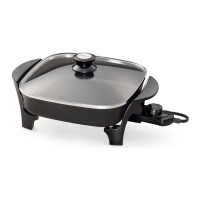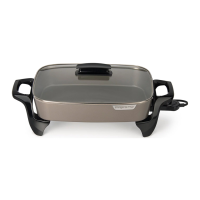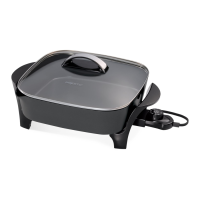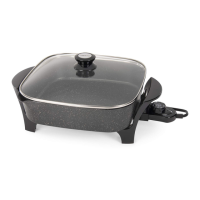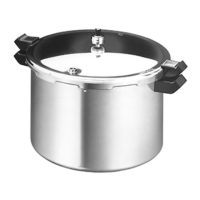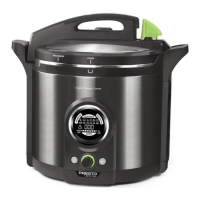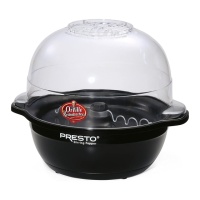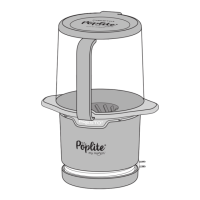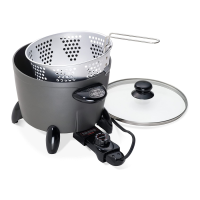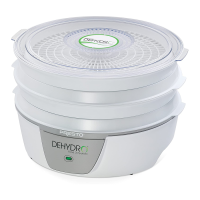5
Determining Dryness
Refer to the Fruit Drying Guide on page 6 and begin checking the fruit at the beginning of the average drying time range. Remove a few
pieces of fruit from each dehydrator tray and allow to cool to room temperature. Fruits are acceptably dry when they are soft and pliable,
but not sticky. Fruit folded in half should not stick together. Apple and banana slices can be dried until crisp, if desired. If fruits seem
to have a lot of moisture remaining, recheck every 1 to 2 hours. If fruits appear to be almost done, check again in 30 minutes. Always
check fruits from each tray.
Conditioning
After drying, allow fruit to cool for 30 minutes to 1 hour before packaging. Dried fruits may have uneven amounts of moisture remain-
ing because of differences in the size of various pieces. Although fruit appears to be dry, there may still be moisture remaining in some
of the individual pieces. Conditioning is a procedure that can be used to more evenly distribute moisture, reducing the chances of mold
growth and allows you to determine if you’ve removed enough moisture before storing. To condition, place the pieces of fruit loosely
in a clean plastic or glass container and seal and let stand for 1 week. This will allow drier pieces of fruit to absorb excess moisture that
may be present in other pieces. Daily shake the jar to separate the pieces and look for condensation. If condensation develops, remove
the fruit and dehydrate for additional time. After conditioning, follow “Packaging and Storaging Dried Food” information on page 10.
Uses
Dried fruits make great snacks. They can also be added to trail mixes, cereals, muffins, breads, and other baked products. Dried fruit can
be used as is or softened prior to use. To soften dried fruit, submerge in boiling water and soak for 5 minutes or place fruit in a steaming
basket over a pot of boiling water and steam for 5 minutes or until fruit is plumped.
Fruit Rolls (Leather)
Fruit rolls (or fruit leather) are made by drying a thin layer of puréed fruit on a flat surface. Once dried, the fruit layer is pulled from the
surface and rolled. The term leather derives from the leather-like texture of the puréed fruit once it is dried.
Almost any fruit or combination of fruit can be puréed and dried for fruit rolls. The quality of the fruit roll depends on whether the fruit
has a low or high amount of the naturally occurring starch called pectin. Fruits that have a high amount of pectin will bond together in
a solid sheet and easily peel, while fruits that have little pectin will flake and crack rather than peel. When using fruits low in pectin,
add another fruit that is high in pectin to improve the texture of the roll. Fruits naturally high in pectin are apples, apricots, blueberries,
cranberries, figs, grapes, peaches, pears, pineapples, and plums. Fruits low in pectin include cherries, citrus fruits, raspberries, and straw-
berries. When using a low pectin fruit with a high pectin fruit, use equal parts of each to produce the best results.
Preparation
Use a Presto
®
Fruit Roll Sheet to prepare fruit rolls. Apply a thin layer of vegetable oil or no-stick cooking spray to the fruit roll sheet.
CAUTION! If using cooking spray, be sure to spray away from the dehydrator base, as spray is flammable.
Use about 1½ cups of puréed fruit for each fruit roll sheet.
Select ripe or slightly overripe fruit and remove any bruised areas. Wash fruit and remove peel, seeds, and stems. Cut fruit into chunks
and, using a food processor or blender, purée until smooth (applesauce consistency). To get the puréeing process started, you may need
to add approximately 1 tablespoon of fruit juice or water.
If desired, fruit can be pretreated to preserve its natural color. Add 1½ teaspoons of lemon juice to each 1½ cups puréed fruit. See the
Fruit Drying Guide on page 6 to determine which fruits will benefit from pretreatment.
The natural sweetness of fruit is intensified with drying. However, if your preference is for a sweeter fruit roll, you can add honey, maple
syrup, corn syrup, or sugar to the puréed fruit. Try different amounts of sweeteners, starting with 1 tablespoon for each 1½ cups of fruit
purée, to find your preference. Fruit with sweeteners added will take longer to dry than fruit that is not sweetened.
Canned fruit can also be used to easily make fruit rolls. Drain juice from fruit, saving juice for later use. Place fruit in food processor or
blender and purée until smooth. Applesauce can be used directly from the container.
For frozen fruit, thaw and purée until smooth.
While lightly oiled fruit roll sheet is sitting on counter, pour puréed fruit onto it. Spread with a spatula to form a uniform layer about
¼ inch thick. Position filled fruit roll sheet on dehydrator tray and then place tray onto power base, being careful not to spill the fruit
purée onto the base. Set temperature to 135°F (57°C), and begin drying. Average drying time for all fruit rolls is 4 to 7 hours.
Determining Dryness
Acceptably dried fruit rolls will be slightly tacky to the touch, but will not indent when touched in the center. Begin checking the fruit
roll after 4 hours of drying. If drying more than one fruit roll, be sure to check all of the trays. If additional drying time is needed, recheck
every 30 minutes.
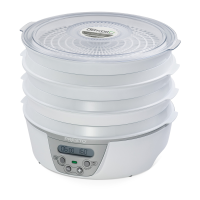
